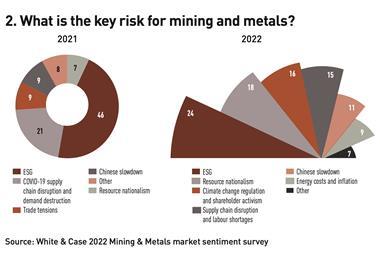Incentivising carbon capture would free institutional investors from having to make decisions about the climate
The title is not a misprint. Responsible investors face a dilemma. Many have made commitments to net zero and managing down the carbon footprint of their portfolio in response to shareholder and employee pressure – not to mention lectures over the dinner table from eloquent 12-year-old daughters.
Industry-wide initiatives under the Glasgow Financial Alliance for Net Zero (GFANZ) are pushing for portfolio standards that make it increasingly difficult to finance new fossil fuel projects. But high fossil fuel prices, high dividend yields from extractive fossil fuel companies and an uncertain outlook for global energy supply all make a strong financial case for maintaining or even increasing exposure to fossil fuel assets.
And developing countries with the most attractive opportunities in this space are justifiably calling out the hypocrisy of rich countries discouraging investment in new fossil fuel projects overseas, while at the same time encouraging domestic extraction to boost non-Russian supplies. So, what is a responsible investor to do?
The first step is to imagine a future in which you did not have to make a choice between investing for risk and return to match your liabilities and worrying about whether your investments are rendering our planet uninhabitable.
Whatever your views on the relative importance of the climate issue versus the myriad other issues facing the world today, one thing we can all agree on is that an investor or fund manager, even after taking a course in ESG, is probably not best equipped to make decisions about the future of our climate.
You have better things to do with your time and your finance degree than worry about which technologies should be considered green, the appropriate role of nature-based solutions, which offset schemes to use and so forth.
There are plenty of consultants available to relieve you of that task, for a fee: to evaluate your performance, and advise you how to improve it, against some benchmark, metric or industry standard that they probably had a hand in devising. But the more complex the benchmark, the more it depends on the views and priorities of the benchmark designers.
These may be very obscure, deeply embedded in the ‘integrated assessment models’ used to generate so-called science-based emissions scenarios. How can you be confident that these views and priorities reflect your own, or those of your clients.
Investing to targets
The point of a market is to capture the diverse opinions of participants, each of whom has a stake in the outcome. Markets are affected by the decisions of external parties, such as central banks setting interest rates. But these interactions tend to work best when the external parties are responding transparently to publicly available data using a small number of well-understood tools in pursuit of a pre-defined goal, such as a long-term inflation target.

We all understand the overarching goal of limiting global warming to well below 2°C and as close as possible to 1.5°C. That is what 190 countries have signed up to in the Paris Agreement in 2015, and despite lack of progress in reducing emissions, enthusiasm for the long-term temperature goal appears stronger than ever: language on 1.5°C was strengthened at COP26 in Glasgow, and reiterated in COP27, with an acknowledgment that this would require net zero emissions “around mid-century” rather than “in the second half of this century” as agreed in Paris.
Accumulating evidence of the impacts of climate change, in observed heatwaves, wildfires, floods and droughts, will make it ever harder for governments to back-track, and as the UN “stocktake” process gathers momentum, it will also become harder to dissociate inadequate near-term emissions targets from ambitious long-term temperature goals.
Whatever your personal views on whether 2% is the right inflation target, if 2% is the target adopted by your central bank, you invest accordingly. Likewise, you may have your own views on how much warming it is fair to inflict on the inhabitants of the 22nd century, but you should take those up with your 12-year-old daughter.
The world’s governments are committed to limiting warming to well below 2°C, which means reducing carbon dioxide emissions to net zero soon as possible after 2050. You may also have doubts about their ability to deliver, just as you might be sceptical about the political independence of your central bank, but at least you know what they are trying to do.
Indices of progress towards net zero
When it comes to sector-level or company-level decarbonisation targets, however, things become murkier. How can anyone determine objectively whether the activities of a diversified mining conglomerate are “consistent with 1.5°C,” especially when the activities of the world as a whole are not?
The answer depends on the assumed details of the transition, including the market shares of nuclear, renewable and fossil fuels with and without carbon capture and storage in the global energy mix of 2050. Scenario-builders invariably take a view on these things, but what gives them the right to determine the correct answer?
At a recent meeting, an ESG consultant showed a graphic of eight major oil-and-gas companies, ranked according to the fraction of current investment in renewable energy. The lowest-ranked company was one that had decided to focus on its core business and invest in carbon capture and storage, aiming to dispose of one tonne of carbon dioxide back into the earth’s crust for every tonne generated by its activities and products by mid-century.
I believe, if delivered, that is precisely what a responsible oil-and-gas company should be doing, and I really don’t care how much they invest in renewables in the meantime.
Yet in the view of that ESG consultant, that was the wrong answer.
So how can we identify clear, transparent and hard-to-game indices of progress towards net zero that work at a company level and don’t involve unaccountable standard-setters taking prescriptive views?
One candidate is absolute emissions, but even if we set aside arguments over ‘scope’ – the degree to which a company is responsible for emissions generated by its suppliers or customers – simply requiring individual companies to reduce their emissions can have perverse consequences, most obviously encouraging a shift of fossil-intensive activities towards companies, regions and investors who are less accountable to climate-conscious investors.
Indices that encourage responsible companies to reduce their market share in a problematic sector are generally a bad idea.
Towards geological net zero
So, what is the alternative? One option that is getting more attention as the challenge of phasing out fossil fuels entirely becomes clearer is geological carbon intensity: of the fossil-origin carbon dioxide generated by the fossil fuels used, sold or otherwise critical to a company’s long-term business model, what percentage is permanently restored to the geosphere, meaning injected back into the Earth’s crust or some other equally permanent storage?
This fraction, currently 0.1% globally, will almost certainly need to reach 100% for the world as a whole to achieve geological net zero, as required for a durable halt to global warming. Compensating for fossil fuel emissions by restoring carbon to the biosphere (plants and biologically active soils) is a helpful, popular but limited solution.
Trees take time, space and water to grow, so even the most optimistic estimates of the potential of nature-based solutions show them contributing a relatively small fraction (less than 20% in most scenarios) of the ongoing carbon storage required in the second half of this century, approximately what is needed to compensate for emissions from food production or ongoing carbon release resulting from historical warming. Any ongoing fossil fuel use – and there is plenty in all scenarios that don’t explicitly ban it – must be compensated for with geological storage.
So, if you want your investments in fossil fuels to be clearly aligned with net zero by mid-century and limit the risk of asset stranding, the companies you own need to be storing 10% of the carbon dioxide generated by their activities and products back into the earth’s crust by the early 2030s, or paying someone else to do the same, with capacity in place to increase that fraction to 100% by 2050. They are more than capable of achieving this, but claim their shareholders would not like it and it would do nothing for their ESG rating. Time for that to change.






























No comments yet